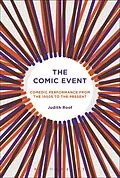The Comic Event approaches comedy as dynamic phenomenon that involves the gathering of elements of performance, signifiers, timings, tones, gestures, previous comic bits, and other self-conscious structures into an "event" that triggers, by virtue of a "cut," an expected/unexpected resolution. Using examples from mainstream comedy, The Comic Event progresses from the smallest comic moment-jokes, bits-to the more complex-caricatures, sketches, sit-coms, parody films, and stand-up routines. Judith Roof builds on side comments from Henri Bergson's short treatise "Laughter," Sigmund Freud's Jokes and Their Relation to the Unconscious, and various observations from Aristotle to establish comedy as a complex, multifaceted practice. In seeing comedy as a gathering event that resolves with a "cut," Roof characterizes comedy not only by a predictable unpredictability occasioned by a sudden expected/unexpected insight, but also by repetition, seriality, self-consciousness, self-referentiality, and an ourobouric return to a previous cut. This theory of comedy offers a way to understand the operation of a broad array of distinct comic occasions and aspects of performance in multiple contexts.
Autorentext
Judith Roof is the William Shakespeare Chair in English at Rice University, USA. She is the author of The Comic Event: Comedic Performance from the 1950s to the Present (Bloomsbury, 2018), What Gender Is, What Gender Does (2016), as well as five other monographs, six edited (or co-edited) books, and more than 80 essays on topics ranging from modern drama to The Big Lebowski, Ethel Merman, Posthumanism, the novels of Percival Everett, the work of Rabelais, Beckett, Pinter, Duras, psychoanalysis, narrative theory, film studies, genetics, critical legal studies, and secondary characters.
Klappentext
The Comic Event approaches comedy as dynamic phenomenon that involves the gathering of elements of performance, signifiers, timings, tones, gestures, previous comic bits, and other self-conscious structures into an "event" that triggers, by virtue of a "cut," an expected/unexpected resolution.
Using examples from mainstream comedy, The Comic Event progresses from the smallest comic moment-jokes, bits-to the more complex-caricatures, sketches, sit-coms, parody films, and stand-up routines. Judith Roof builds on side comments from Henri Bergson's short treatise "Laughter," Sigmund Freud's Jokes and Their Relation to the Unconscious, and various observations from Aristotle to establish comedy as a complex, multifaceted practice. In seeing comedy as a gathering event that resolves with a "cut," Roof characterizes comedy not only by a predictable unpredictability occasioned by a sudden expected/unexpected insight, but also by repetition, seriality, self-consciousness, self-referentiality, and an ourobouric return to a previous cut. This theory of comedy offers a way to understand the operation of a broad array of distinct comic occasions and aspects of performance in multiple contexts.
Inhalt
Prolegomenon: "a pert challenge flung at philosophic speculation"
Bit I: "At First Mere Improvisation"
Bit II: Reverberations: The Joke of the Joke
Bit III: Repetition and the Exquisite Seriesness of Series
Bit IV: "Play It Again, Sheldon" Nothing in Comedy Ever Only Happens Once
Bit V: The Comic Uncanny; or The Character of Caricature
Bit VI: Breaking Stacks and Cutting Layers: The Self-conscious Comedy of Comedy
Bit VII: Doubling Down on the Mise en Abyme: The Comic Contexts of Comedy
Bit VIII: Ourobouros-Epanalepsis: "a pert challenge flung at philosophic speculation"
Bit IX: Ourobouroubouroubouros; Or When Parody Takes Itself On
Bit X: The Long and Winding Road
Epilogue: The Aristocratic Apparatus
